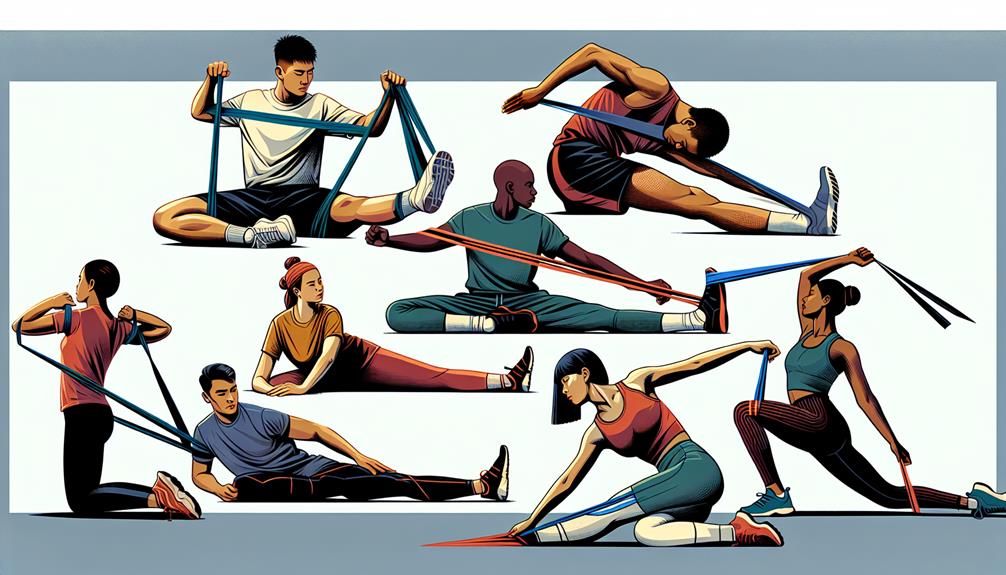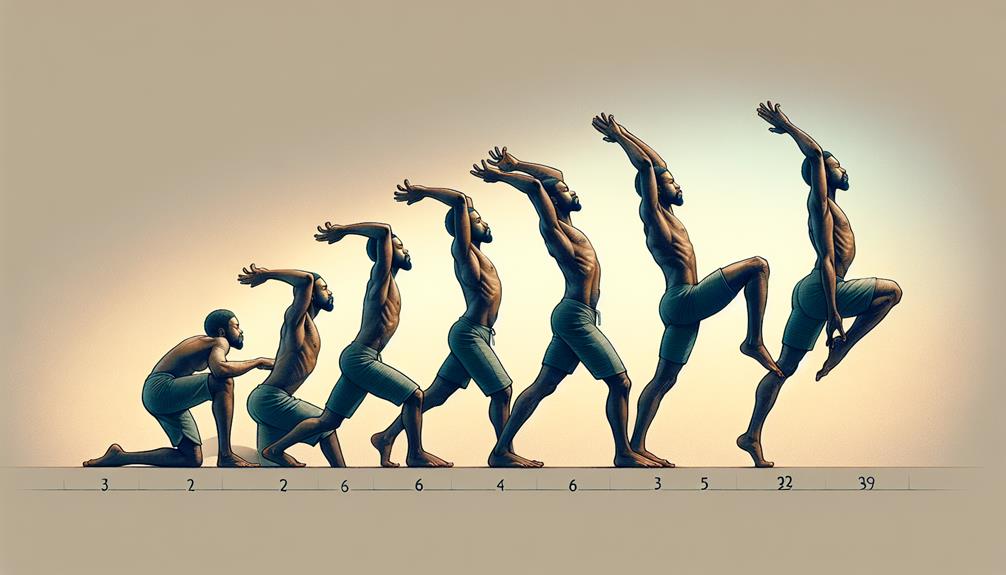Are you looking to enhance your physical abilities and move with greater ease? Discover the benefits of flexibility training programs, as they hold the key to unlocking your range of motion and mobility. By incorporating various flexibility techniques into your routine, you can improve your overall flexibility levels and maintain them over time. But before diving into the details of designing a customized program, it is crucial to assess your current range of motion. Curious to learn more? Stay tuned to find out how flexibility training can transform the way you move and perform.
Benefits of Flexibility Training
Flexibility training offers numerous benefits for individuals seeking to improve their range of motion and joint mobility. One of the key advantages of flexibility training is improved athletic performance. When your muscles and joints are flexible, you can achieve a greater range of motion during physical activities. This means you can move more efficiently and effectively, enhancing your overall performance. Whether you are an athlete or someone who enjoys recreational activities, increased flexibility can give you a competitive edge.
Additionally, flexibility training plays a crucial role in injury prevention. By regularly engaging in stretching exercises, you can improve the elasticity of your muscles and tendons, which helps to reduce the risk of strains and sprains. Flexibility training also helps to maintain proper alignment of the joints, reducing the likelihood of overuse injuries. When your muscles are flexible and balanced, they can absorb impact more effectively, protecting your body from excessive stress and strain.
Assessing Your Current Range of Motion
To accurately assess your current range of motion, it is essential to perform specific flexibility tests that target various muscle groups and joints. Analyzing limitations in your range of motion can help identify areas that require improvement and guide your flexibility training program. Here are three flexibility assessment techniques that can provide valuable insights:
- Goniometry: This technique involves using a goniometer, a specialized tool, to measure the angles of joints. By measuring the range of motion at different joints, such as the shoulder, hip, or knee, you can identify any restrictions or asymmetries.
- Sit-and-reach test: This test primarily assesses hamstring and lower back flexibility. It involves sitting on the floor with legs extended and reaching forward as far as possible. The distance reached is measured to determine the flexibility of the posterior chain.
- Shoulder flexion test: This test evaluates the flexibility of the shoulder joint. You raise your arm forward and overhead while keeping it straight. The goal is to achieve a 180-degree angle between your arm and trunk.
Designing a Customized Flexibility Program

When designing a customized flexibility program, it is crucial to consider individual goals, current range of motion, and specific muscle groups that require improvement. To achieve optimal results, a combination of static stretching and dynamic stretching exercises should be incorporated into the program.
Static stretching involves holding a stretch for an extended period, typically between 20 to 30 seconds. This type of stretching helps improve flexibility by elongating muscles and increasing the length of tendons and ligaments. It is particularly effective for increasing the range of motion around a joint.
On the other hand, dynamic stretching involves moving parts of your body through a full range of motion. This type of stretching not only helps improve flexibility but also prepares your body for physical activity. Dynamic stretching exercises simulate movements that will be performed during workouts or sports activities, effectively warming up the muscles and increasing blood flow.
When designing a customized flexibility program, it is important to choose stretches that target specific muscle groups that require improvement. By focusing on these areas, you can effectively address any imbalances or tightness that may be limiting your range of motion.
Incorporating Various Flexibility Techniques
To further enhance the effectiveness of your customized flexibility program, incorporate a variety of flexibility techniques that target specific muscle groups and address imbalances or tightness to improve your overall range of motion. By incorporating these techniques into your routine, you can maximize the benefits of your flexibility training and achieve greater mobility.
- Yoga and Pilates: These practices focus on stretching and strengthening muscles through controlled movements and deep breathing. Yoga poses and Pilates exercises help improve flexibility, balance, and core strength, making them excellent additions to your flexibility program.
- Dynamic Stretching: This technique involves moving your muscles and joints through a full range of motion in a controlled and fluid manner. Dynamic stretching not only increases flexibility but also prepares your body for physical activity by activating the muscles and boosting circulation.
- Mobility Exercises: These exercises aim to improve the functional range of motion in your joints. They often involve movements that mimic everyday activities to enhance your overall mobility and flexibility.
Incorporating a combination of yoga and Pilates, dynamic stretching, and mobility exercises into your flexibility program can provide a comprehensive approach to unlocking your range of motion and improving your overall mobility. Remember to consult with a qualified professional to tailor these techniques to your specific needs and goals.
Progressing and Maintaining Flexibility Levels

To progress and maintain your flexibility levels, it is essential to regularly engage in a consistent and progressive flexibility training program. A progressive program gradually increases the intensity and duration of exercises over time, challenging your muscles and joints to adapt and improve their range of motion. This approach helps to prevent plateaus and ensures continuous improvements in flexibility.
One effective method to progress flexibility is through the use of dynamic stretching exercises. Dynamic stretching involves moving your muscles and joints through a full range of motion, promoting increased blood flow and flexibility. Examples of dynamic stretches include leg swings, arm circles, and trunk rotations. These exercises should be performed before a workout or physical activity, as they help to warm up the muscles and prepare them for movement.
Another way to progress flexibility is by incorporating static stretching into your routine. Static stretching involves holding a stretch for a prolonged period, typically around 30 seconds. This type of stretching helps to improve the elasticity of muscles and connective tissues, allowing for greater flexibility and mobility. Examples of static stretches include hamstring stretches, quadriceps stretches, and shoulder stretches.
To maintain mobility, it is crucial to continue with regular flexibility training even after reaching your desired level of flexibility. Without consistent training, your muscles and joints may gradually lose their newfound range of motion. Aim to incorporate flexibility exercises into your fitness routine at least two to three times a week, focusing on both dynamic and static stretches.
Remember, progressing flexibility and maintaining mobility require consistency and dedication. By following a progressive flexibility training program and incorporating regular stretching into your routine, you can unlock your body's full range of motion and enjoy improved flexibility and mobility.
| Dynamic Stretching | Static Stretching |
|---|---|
| Leg swings | Hamstring stretches |
| Arm circles | Quadriceps stretches |
| Trunk rotations | Shoulder stretches |
Table 1: Examples of dynamic and static stretching exercises to help progress flexibility and maintain mobility.
Frequently Asked Questions
Are Flexibility Training Programs Suitable for All Fitness Levels and Ages?
Flexibility training programs can benefit individuals of all fitness levels and ages. They provide specific exercises and techniques to improve range of motion and mobility, making them suitable for seniors and beginners alike.
Can Flexibility Training Reduce the Risk of Injury During Physical Activities?
Flexibility training can reduce injury risk by improving your overall range of motion and mobility. Incorporating flexibility exercises into your workout routine helps to increase joint flexibility and muscle elasticity, promoting better movement patterns and decreasing the likelihood of strains or tears during physical activities.
How Long Does It Take to See Improvements in Range of Motion With Flexibility Training?
With flexibility training, you'll see range of motion progress in as little as four weeks. Consistent effort is key, as it takes time for your muscles and joints to adapt. Stick to the program and reap the benefits.
Can Flexibility Training Improve Athletic Performance?
Flexibility training can significantly improve your athletic performance. It enhances your range of motion, allowing for better movement efficiency and reduced risk of injury. It also contributes to overall health and well-being, and aids in rehabilitation and injury prevention.
Are There Any Potential Risks or Precautions to Consider Before Starting a Flexibility Training Program?
Before starting a flexibility training program, it is important to consider potential risks and take necessary precautions. Understanding your body's limitations, seeking professional guidance, and gradually increasing intensity can help prevent injuries and optimize results.
Conclusion
In conclusion, flexibility training programs serve as the key to unlocking the doors of range of motion and mobility. By assessing your current range of motion and designing a customized program, you can effectively improve your flexibility levels. Incorporating various flexibility techniques and consistently progressing in your training will ensure that you maintain and enhance your flexibility over time. Embrace the symbolic power of flexibility and open up a world of movement possibilities.













